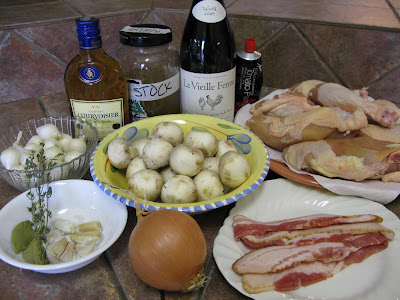Here's Mary:
The ingredients for this dish are basically a whole chicken, already cut up, bacon, mushrooms (champignons), pearl onions, garlic, and herbs. Red wine, chicken stock, Cognac, and tomato paste add to the flavor complexity.
The bacon is browned in butter in a Dutch oven, then the chicken is added in small batches and browned. Once all the chicken pieces are browned, simmer all of it in the pot for 10 minutes. The only liquid in the pot at this point is the fat from the butter, the bacon, and the chicken.
About a quarter cup of Cognac is added and ignited. The vapors of the Cognac are volatile, so the match or igniter can be placed just inside the dutch oven and it will light right up. We tried to take a photo, but the flame is a pale blue, hard to see. The pan is shaken and the flame dissipates quickly, leaving only the flavor elements of the Cognac.
I added three cups of red wine, which is basically a regular size bottle of wine. Here, you see Brian pouring from a one cup measure because we finished off one bottle of wine and used part of another, so we were trying to be a little precise.
After the wine, I added enough chicken stock to cover the chicken. As I have said in earlier blog posts, homemade stock makes such a noticeable difference in the quality of the dish when it comes to the table. You can buy chicken, make the stock, then freeze it for future use. In this photo, you also see the herbs, bay leaf, and tomato paste. The chicken is simmered for half an hour, then the chicken pieces are taken out (and kept warm) while you reduce the liquid. This is the tricky part for me, as it doesn't always get as thick as it's supposed to get.
Here is the final product. You see I paired it with parsley potatoes and peas. You can use whatever you prefer as side dishes. These peas are called lady peas here in the South. We grew our own parsley in a pot on our deck, perfect for wintertime.
Here's Brian again, talking about the wine.
You might think a chicken dish always calls for a white wine, but Coq au Vin actually pairs much better with red wine, which Julia also recommends in her book. Plus, the dish is cooked with red wine. Many wines would be excellent choices, but we selected a powerful California Cabernet Sauvignon to see how the dish would stand up to a really robust wine. It turned out to be an excellent choice. The richness and complexity of the dish was every bit the match of the wine. The fruitiness and softness of the wine from Sonoma Valley created a flavor sensation that was just wonderful on the palate.
B.R. Cohn is a producer in the Sonoma Valley of Sonoma County, not far from the town of Sonoma on Highway 12. Olive Hill is a vineyard on their property and that's where the grapes for this wine are grown. They even produce their own olive oil right on the property. This wine is 100% Cabernet Sauvignon. We purchased the wine at the winery on one of our wine vacations. It has been lying in our cellar for at least seven years, waiting for this dinner. Here are my notes on the wine.
Definitely New World in style, it was delicious, nonetheless. The aroma profile was not distinctly Cabernet, but it had lovely dark cherry and plum on the nose. It didn't have the cedar, herbs, or tobacco of many Napa Valley or Bordeaux wines. The palate had good structure, even a bit drying, indicating the tannins were not fully resolved, but the texture was very smooth anyway. The acidity was on the low side of medium, but the wine was nicely balanced. All that California sunshine came through with cherry, plum, and currant fruit. It was nicely balanced, moderately complex, and medium in length. I would describe it as a good wine, bordering on excellent. We agreed it was delicious. 14.0% alcohol. We paid $40 at the winery.
That's our post for today. We hope you enjoyed it and that our posts are interesting to you. We'd like to hear your comments and ideas! In the meantime, check back again for more blog entries at Cèpage et Cuisine.
Cheers,
Brian♥Mary











No comments:
Post a Comment